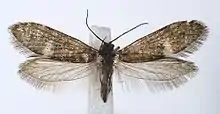Eriocrania sangii
Eriocrania sangii is a moth of the family Eriocraniidae. It is found in Europe.
| Eriocrania sangii | |
|---|---|
 | |
 | |
| Scientific classification | |
| Kingdom: | Animalia |
| Phylum: | Arthropoda |
| Class: | Insecta |
| Order: | Lepidoptera |
| Family: | Eriocraniidae |
| Genus: | Eriocrania |
| Species: | E. sangii |
| Binomial name | |
| Eriocrania sangii (Wood, 1891) | |
| Synonyms | |
| |
The wingspan is 9–14 mm. Edward Meyrick gives this description: head whitish-grey-ochreous, more or less mixed with dark fuscous. Antennae 1/2. Forewings elongate, bronzy-purple, with more or less numerous pale shining golden irregular spots: a subtriangular pale golden dorsal spot before tornus, reaching half across wing; cilia bronzy-grey, on dorsal spot ochreous-whitish; 9 absent. Hindwings bronzy-grey, towards apex purplish-tinged. Larva grey; head black, centre and mouth brown; 2 with two groups of black spots: in brownish blotch in leaves of birch. The moth flies from March to April depending on the location.[1]
The larvae mine the leaves of Betula species.
References
- Meyrick, E., 1895 A Handbook of British Lepidoptera MacMillan, London pdf
 This article incorporates text from this source, which is in the public domain. Keys and description
This article incorporates text from this source, which is in the public domain. Keys and description
This article is issued from Wikipedia. The text is licensed under Creative Commons - Attribution - Sharealike. Additional terms may apply for the media files.